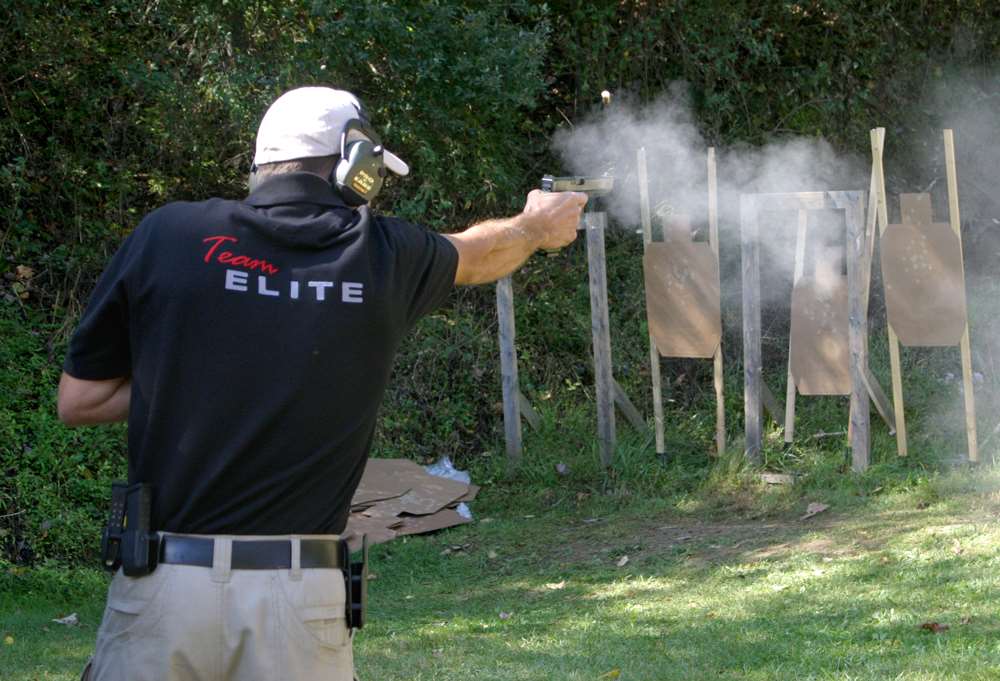
Shooters entering the Action Pistol arena will need to digest a lot of new information and rules. The Power Factor (PF) is one, and it's critical. It mandates the power level of the ammunition allowed and can determine which gun division a shooter should compete in—or if they're even allowed to compete.
The procedure for determining the PF for any load is a simple mathematical formula: Multiply the bullet's weight by its velocity over a chronograph (which will be used at major matches) and divide the resulting figure by 1000.
That figure will be the PF for that load, regardless of the caliber. If that figure meets, or exceeds, the required minimum PF for the gun division or game being played it's legal. If not, a shooter can be disqualified from the match.
The formula to determine PF deals only with the bullet weight and its velocity—not with the caliber. Nor is there one universal PF. Different competitive organizations often use differing Power Factors.
For example, Steel Challenge has no PF requirement. If the load will safely operate the gun it's allowed. ICORE and the Bianchi Cup keep things simple with a 120 PF across the board. USPSA has two: 125 Minor and 165 Major. Things get much more complicated with IDPA because they use five PFs; based upon the gun divisions, and in one case the guns used within a division.
IDPA shooters in Stock Service Pistol (SSP), Enhanced Service Pistol (ESP) and Compact Carry Pistol (CCP) require a 125 PF. Custom Defensive Pistol (CDP) must use a .45 ACP at a 165 PF. Back-Up Gun (BUG) requires only a 95 PF. Additionally, the newly modified Revolver Division allows shooters with .38 Special and larger revolvers that are reloaded with a speedloader to use a 105 PF, while those shooters using moon clips to reload must make a 155 PF.

All the above figures are the minimum allowed, but savvy shooters don’t handload to the minimum figure. Chronographs can vary slightly, temperature extremes can alter velocities, and even slightly differing internal case volumes among different head stamps can alter velocities downward. Experienced shooters normally load to an average factor of +5 PF: making a Major load a 170, and a Minor load a 130 PF.
The original intent of the Power Factor was to prevent shooters from using extremely light “Mouse Puff” loads and require the use of full-powered ammunition. It achieved that—to a degree. Full-powered factory loads will normally produce a PF anywhere from 13 to 40 PF above the required minimum and will be legal. But savvy handloaders have figured out how to create loads that meet the required PF with considerably less recoil.
Thus, the Power Factor formula leans heavily towards bullet weight. Any bullet weight suitable for the commonly-used calibers (.45 ACP, .40 S&W, 9 mm, .38 Special or .38 Super) can be driven to a velocity that will make the PF. But, heavier bullets have an advantage.
It's often assumed that heavier bullets produce more recoil than lighter bullets. But that's only true if both are loaded to full SAAMI pressures. Regardless of the caliber used, a small charge of fast burning powder with a heavier bullet in a reduced load will produce recoil that is a softer push, and with less muzzle rise than lighter bullets making the PF. Lighter bullets require higher velocities, more powder to reach them, and produce a snappier recoil with more muzzle rise.

For example, the traditional load in the .45 ACP is a 230-grain bullet at about 860 feet per second (FPS). That's a 197 PF. Handloading a 230-grain bullet at about 740 FPS makes a comfortable 170 Major power factor with considerably less recoil.
In the .40 S&W, the standard factory load is a 180-grain bullet at about 990-1000 FPS for a 180 PF. Loading a 200-grain bullet at 850 FPS gets a Major 170 PF, with softer recoil than the 180-grain load.
While the .45 ACP and .40 S&W are normally considered Major calibers, both can be handloaded to a Minor 125 PF and shot in those divisions where their gun type is allowed. A 200-grain bullet at 675 FPS makes a 135 PF and redefines the term “Mouse Puff” load. A 180/185-grain bullet at 725 FPS also makes a comfortable 130+PF with very soft recoil.
The 9 mm is the most popular Minor caliber and factory loads in 115-and 124-grains all make a PF in the 138 to 141 range. The standard factory load for the 147-grain load is in the 990-1000 FPS range and makes about a 147 PF. Loading a 147-grain slug at 880 FPS makes a 130 PF and provides the same soft push recoil as the heavy bullets/fast powder loads in the .45 and .40.
While heavy bullets and fast powders produce a softer recoil push, there are shooters who prefer the snappier recoil of the lighter bullets. Some feel that the quicker recoil cycle gets them back on target faster. Those who understand the Power Factor can try both, and choose the load that works best for them.


































